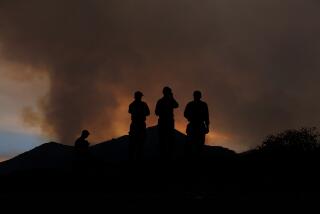A Dozen Wildfires Lay Siege to State : Disaster: Gov. Wilson issues emergency declaration after touring scorched area. Thousands are forced to flee homes.
- Share via
ANGELS CAMP, Calif. — Firefighters scrambled to battle a dozen significant wildfires from one end of California to the other while Gov. Pete Wilson declared a state of emergency Friday in the Mother Lode as well as Shasta County, where 35,000 acres were scorched in the season’s largest forest fire.
“We’re moving toward a fire siege, I think,” said California Department of Forestry and Fire Protection spokeswoman Carol Williams-Bryant.
As victory was declared over the Mother Lode fire that had charred 18,000 acres and forced the evacuation of up to 14,500 people--almost half the residents of Calaveras County--officials were redirecting firefighting crews 250 miles north to Shasta County.
“They are demobilizing as quickly as they can (in Calaveras County) and redeploying to other incidents,” said Karen Terrill, spokeswoman for the forestry department.
In the rugged Inyo National Forest in Southern California, about 1,000 people were forced to evacuate their homes and the fire burned toward Mammoth Lakes, about three miles from the town of Mammoth. The terrain was so steep and remote that fire crews had to be flown in by helicopter.
Forestry officials commandeered four huge C-130 air tankers from the National Guard and outfitted them so they could be used to bomb the Inyo fire with 3,000-gallon loads of water.
Six air tankers, which carry 800 gallons each, remained grounded because of cuts in the Department of Forestry budget.
The Shasta County fire rolled through the town of Round Mountain late Thursday, damaging or destroying up to 60 structures. Located 30 miles east of Redding, the fire forced 2,000 people to flee their homes. Authorities closed California 299 east of Interstate 5.
On Friday, Department of Forestry officials called for another 850 firefighters to help battle the Shasta blaze, dubbed the Fountain fire because it was first seen from a roadside drinking fountain.
The Fountain fire veered from populated areas Friday and was burning through timberland.
As the worst of the annual fire season hit California hard, fire crews were battling or mopping up six significant wildfires that consumed more than 62,000 acres.
Several smaller grass fires threatened to grow. Three were burning in Yosemite National Park and four were burning in Sequoia National Park. Near Auburn, east of Sacramento, a fast-moving fire consumed 15 structures and forced several people to flee.
The Forestry Department issued a call for 100 15-member crews to be sent from around the country and pressed 16 National Guard helicopters into service to drop water on blazes around the state. More than half of Nevada’s firefighters were battling blazes in California and Idaho on Friday.
Although July is the month when the largest number of fires flare, California’s biggest fires traditionally come in August and September, when hot dry north winds sweep down the state. Forestry officials fear that this year could be especially bad.
“We certainly have the potential for some very large and damaging fires,” Terrill said. “All the conditions are ripe. We have drought damage--dead trees, dead brush--and critically dry conditions up and down the state. Combine that with high temperatures and wind, and it can be a very dangerous combination.”
Speaking at the Calaveras County fairgrounds after touring the fire area, Wilson declared a state of emergency in the Mother Lode and Shasta County. The declaration opened the way for more state financial aid. It also is a step toward seeking federal assistance in the form of low-interest loans.
Wilson praised private vendors who supplied food and material to crews in exchange for state-issued IOUs. He also promised firefighters that they would be paid in real money as soon as a budget is adopted.
“My reaction is one of enormous pride, gratitude and relief,” Wilson said as firefighters gathered at the fairgrounds, where the famed annual frog-jumping contest is held.
“When we have a budget, we will pay them,” Wilson said.
State forestry spokesman Jim Davis attributed the victory over the Old Gulch fire in C alaveras County to the massive amount of equipment and personnel directed at it, plus a drop in temperatures and winds that died down Thursday night.
“The (Calaveras County) fire is under control and it’s not going to get away now,” Davis said. “I would say we’ve won.”
On Friday, smoke cleared from over the Calaveras County towns of Avery, Murphys and Sheep Ranch. Crews monitored embers and fire consumed islands of trees and brush inside the fire line. Residents who were evacuated earlier in the week were expected to return their homes today.
The Old Gulch fire’s toll was placed at $5.7 million, and included 57 structures, of which 42 were homes, plus another 39 outbuildings and 58 vehicles. The fire suppression cost was $10 million.
Malnic reported from Angels Camp and Morain reported from Sacramento.
More to Read
Sign up for Essential California
The most important California stories and recommendations in your inbox every morning.
You may occasionally receive promotional content from the Los Angeles Times.













